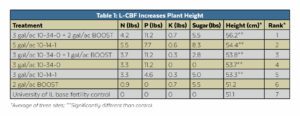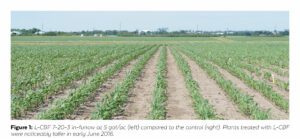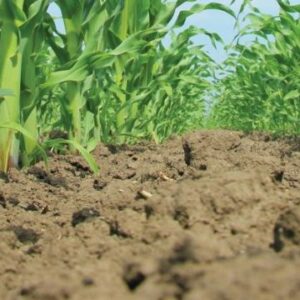Now in its second year, Midwestern BioAg’s liquid carbon-based fertilizer (L-CBF) study at the University of Illinois is once again showing positive results. In early June, Midwestern BioAg scientist Bill Petersen traveled to the University’s research farm and reported back visible improvements in plant height. “Early plant response to L-CBF treatment was consistently positive,” said Petersen. “Plants in treated plots were noticeably taller, validating for the second year that L-CBF application gives plants an early season advantage.”
Derived from cane molasses, L-CBF delivers quality plant nutrients in a carbon base to stimulate soil biology and increase nutrient availability. It can be applied to all major crops and can also be added to most other fertilizers and herbicides.
The L-CBF study, conducted in partnership with QLF Agronomy, analyzes the effects of multiple L-CBF treatments on early season corn growth. The study tracks plant development on three sites, DeKalb, Champaign, and Harrisburg, Illinois, and is overseen by Professor Fred Below and Research Specialist Tryston Beyrer of the University of Illinois Crop Physiology Laboratory.
Stronger Starts
First-year findings showed plants treated with L-CBF were taller on average than the untreated control and 10-34-0 treatments alone. Increasing early season growth in corn carries multiple benefits, including quicker canopy cover, less weed competition, reduced soil evaporation and lower moisture at harvest. A summary of each treatment and its resulting impact on plant height is summarized in Table 1.

2016 Study: New Formulations, Combinations
This year’s study continues to track L-CBF’s impact on corn performance, but includes two new formulations: monopotassium phosphate (MKP) 6-24-6 with L-CBF BOOST, and L-CBF 7-20-3. All plots, including the control, received additional nitrogen per Illinois Extension recommendations prior to planting. Treatments include:
- L-CBF 10-14-1 at 3 gal/ac and 5 gal/ac
- MKP 6-24-6 at 3 gal/ac
- MKP 6-24-6 at 3 gal/ac, with L-CBF BOOST at 1 gal/ac and 2 gal/ac
- L-CBF 7-20-3 at 3 gal/ac and 5 gal/ac
Currently under development, L-CBF 7-20-3 combines the benefits of L-CBF’s molasses base with an additional high-quality phosphorus source. It has a higher ratio of ortho to poly phosphates, a feature often touted for improving season-long nutrient availability.
Figure 1 compares L-CBF 7-20-3 in-furrow at 5 gal/ac (left) to the control (right). “Plants in the treated study were taller and more robust,” said Petersen. “The added phosphorus in L-CBF 7-20-3 can be very beneficial to corn, especially in central-Illinois soil where we’ve seen bigger responses following phosphorus application.”


